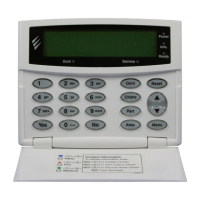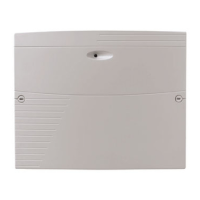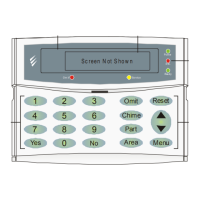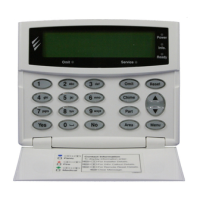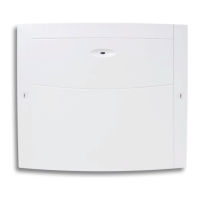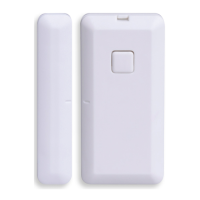Programming the Control Panel Premier 412/816/832 Installation Manual
38 INS159-13
Off: The siren output is normal.
Hardware Options
The hardware options allow you to control which hardware
monitoring features are enabled or disabled. The function of each
option is described as follows:
Panel Output 1 Supervised for Faults
On: Panel Output 1 is supervised and if the device or wiring is
disconnected, the system will generate an “Output 1 Fault”
alarm.
Off: Panel Output 1 is not supervised.
Panel Output 2 Supervised for Faults
On: Panel Output 2 is supervised and if the device or wiring is
disconnected, the system will generate an “Output 2 Fault”
alarm.
Off: Panel Output 2 is not supervised.
Siren/Bell Output Supervised for Faults
On: The Siren/Bell Output is supervised and if the device or wiring
is disconnected, the system will generate a “Siren/bell Fault”
alarm.
Off: The Siren/Bell Output is not supervised.
Panel Box Tamper Switch Monitored
On: The system will monitor the main panel box tamper switch.
Off: The main panel box tamper switch is not monitored.
Auxiliary Fuse Supervised for Faults
On: The Auxiliary 12V Power fuse is supervised, and if the fuse is
blown, the system will generate an “Aux Fuse Fault” alarm.
Off: The Auxiliary 12V Power fuse is not supervised.
Battery Supervised for Faults
On: The Battery is supervised, and if the battery is disconnected
or faulted, the system will generate a “Battery Fault” alarm.
Off: The Battery is not supervised.
AC Mains Supply is Monitored
On: The AC mains supply voltage is monitored, and if the supply
is removed, the system will generate a “AC Fail” alarm.
Off: The AC mains supply voltage is not monitored.
Alarm Call Path Monitored
The alarm call path monitoring depends on the chosen method of
alarm call delivery.
If alarm calls are to be transmitted over the internet (“Connect Via
IP” ARC Protocol Option 8 see page 53)
On: The IP connection is monitored and if the connection is lost a
“Line Fault” will be generated.
Off: The IP connection is not monitored.
If alarms are to be transmitted over the telephone line
On: The telephone line to the control panel is monitored, and if
the telephone line is disconnected, the system will generate a
“Line Fault” alarm.
Off: The telephone line is not monitored.
Auxiliary Input Options
The Auxiliary Input on the main panel PCB can be used for a wide
range of functions, the operation of the input can also be inverted to
allow various wiring options (see page 39). The following Auxiliary
Input functions are available:
Not Used
The Auxiliary Input is not monitored.
Auxiliary Tamper
When activated the panel will generate a tamper alarm for the
assigned partitions (see page 32).
Remote Reset
When activated the system will reset any alarms/faults for the
assigned partitions (see page 32).
Telephone Line Monitor
When activated the system will generate a Telephone Line fault for
all partitions.
Panic Alarm Input
When activated the system will generate an Audible Panic alarm for
the assigned partitions (see page 32).
PA Silent Input
When activated the system will generate a Silent Panic alarm for the
assigned partitions (see page 32).
Latched Keyswitch Input
When the input is active the system will arm the assigned partitions
(see page 32). When the input is inactive the system will disarm the
assigned partitions.
Momentary Keyswitch Input
When the input is activated the system will arm the assigned
partitions (see page 32). When the input is activated again the
system will disarm the assigned partitions.
Both the “Latched” and “Momentary” Keyswitch input types
are ideally suited for use with remote RF fobs as they have a
special auto re-arm feature. When either input type is used to
disarm one or more partitions, the control panel will monitor
all zones activity for 2 minutes. If after two minutes no zones
were activated within the partition that was disarmed, the
panel automatically re-arms the partition. This means even if
the user activates the fob unintentionally and disarms the
system without realising it; the panel will automatically arm
its self after 2 minutes.
Miscellaneous Options 1 -
The function of each option is described as follows:
Enable Bell Squawk on AWAY Arm/Disarm
On: When the system is Away armed, the panel bell/siren output
is pulsed once. On disarming the output is pulsed twice. The
panel bell/siren output must be configured for voltage drive
(see System Options 1.8 on page 37).
Off: The panel bell/siren output behaves normally on Away arm.
Enable Bell Squawk on STAY Arm/Disarm
On: When the system is Stay armed, the panel bell/siren output is
pulsed once. On disarming the output is pulsed twice. The
panel bell/siren output must be configured for voltage drive
(see System Options 1.8 on page 37).
Off: The panel bell/siren output behaves normally on Stay arm.
Disable AC Fail Acknowledgement
On: When the mains supply power fails the Service light will flash
rapidly indicating an AC failure. The system can now be
armed without the need for acknowledging the “AC Fail” fault.
Off: When the mains supply power fails the Service light will flash
normally indicating the “AC Fail” Fault. The fault must be
acknowledged before the system can be armed.

